What is content marketing? Learn how to make the most out of your content marketing to meet your business goals.
Today, I’m going to go ahead and try to answer the super high-level question: what is content marketing?
There’s a ton of interest, energy, and passion around content marketing right now. There are a lot of content marketers that are really doing this right and seeing massive results from this, while a lot of other marketers are failing as well.
Let’s dig here.
What is content marketing?
Content marketing is the act of owning, as opposed to renting media.
Basically, content marketing is designed to create brand awareness, and acquire and convert a very specific target audience with a clear, direct, single-action marketing plan.
You shouldn’t do this because it’s sexy. After all, it’s cool, or because BuzzFeed is doing it. Do it because you want your target audience on your team!
The only reason you should use content marketing is to make a meaningful, measurable impact on your business with your content marketing efforts.
Not everyone needs to invest in a content marketing campaign. But if successful content marketing can give a high return on investment (ROI) to your business, you should do it.
I also need to talk about the differences between content marketing and copywriting, because they are absolutely not the same thing.
Copywriting is the act of content creation that converts traffic into leads (potential customers) and leads into new customers.
So it’s very, very different when compared to content marketing.
Copywriting relates to the creation of the actual pieces of content—the relevant content on the page that you optimize to drive traffic and get users to do the action that we want them to do.
A high-quality copywriting convinces your target audience to take action.
Content marketing should utilize great copywriting and copywriting should be part of a content marketing strategy. These two are not the same thing, but they both work synergistically.
Vanity metrics in content marketing
Like social media, many different vanity metrics are overemphasized in content marketing. Yet, in isolation, these metrics are not very useful at all.
Likes, followers, comments, retweets, fans, subscribers, sparkles, warcraft gold, friendship points, hamburgers—whatever media channel you’re on, there are a ton of vanity metrics around it.
You can create great content but if they don’t tie back directly to your business, they are downright not useful.
I can’t tell you the number of people I meet that talk about their Instagram followers, but then don’t talk about the follow-up to their e-commerce business. Just because your stuff on social media platforms gets liked a lot, it doesn’t necessarily mean it’s good content.
The bottom line is that the effectiveness of content marketing efforts should be measured using metrics that tie to the success of the business: conversion rates, lifetime value, and revenue generated, are just a few examples.
Examples of content marketing
Content marketing is a modern concept and it’s about the merging of your valuable content and advertising.
Let’s look at some examples.
In the past, it was normal to watch an old-school band on a show (let’s say it was The Beatles on The Johnny Carson Show), and then see advertising in between. The Beatles were a kind of content, and then there was advertising for a product (like Kool-Aid) in the 30-second spots.
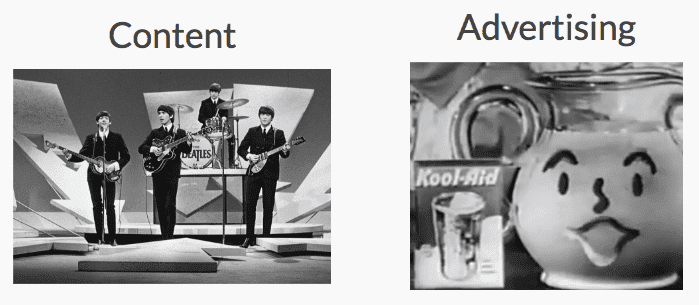
Let’s take an old-school Vogue magazine as an example as well. There was content for the users who bought the subscription (articles, fashion editorials, and so on), and in between the pages with content, there were old-school advertisements (for Camel cigarettes, for example).
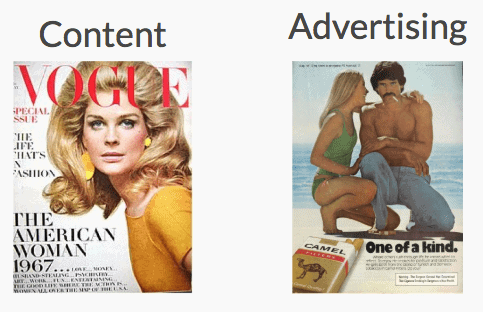
In a soccer game, the game itself is the content, while the jerseys the players wear are all about advertising.
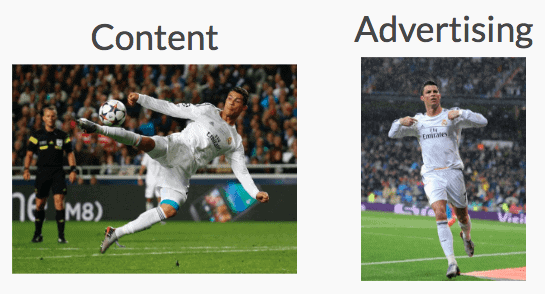
Let’s say you have an article on cnbc.com that gives the users a bunch of content, and then there’s advertising plastered on the site. This is a very modern-day example, but it still kind of pertains to the old-school ways.
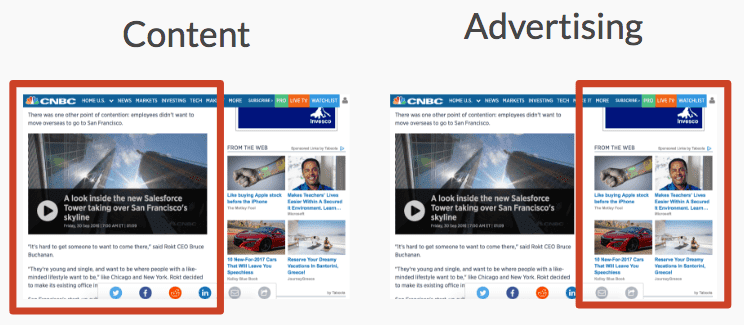
Moving to an even more modern example, below you will see that sumo.com has a great post on how to boost your email opt-in rate by 664% in 24 hours.
Then, they show a form at the top of the page, where you can enter your URL to test their optimization tool. This content (the article) is owned by the advertiser (Sumo), who uses it for content marketing.
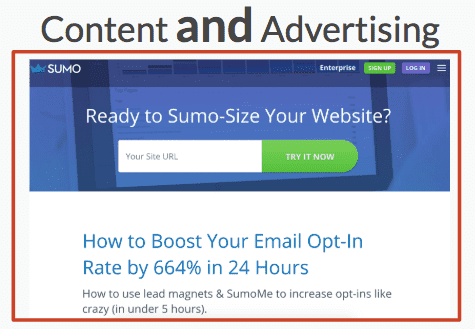
The content itself becomes advertising and the advertiser is the one who creates the actual content.
In the old-school version, the TV program was not hosted by the advertisers—they just purchased the time slot for their commercials. In digital marketing, the advertiser hosts and creates the content.
That is, fundamentally, what content marketing means.
If you’re looking into investing in content marketing it can be hard to know where to start: should you create a podcast? Start blogging? Create a video content strategy? Will case studies or infographics be the best content for your audience?
We created a framework to help with that.
The Content Marketing Framework
Content marketing applies to every stage of the funnel.
Let’s say you know how users go from visiting your website to purchasing your product or service, you have your customer demographics, and you have each phase of your customer journey clearly defined.
Your marketing team can use content marketing to move users from one phase to the next.
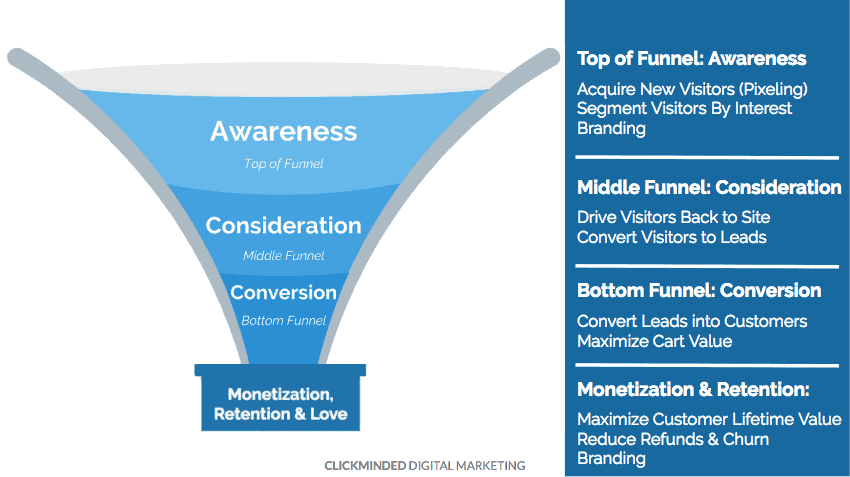
At the top of the funnel is the Awareness phase, the middle of the funnel is the Consideration phase, and the bottom of the funnel is the Conversion phase. Once converted, customers will get into the Monetization, Retention, and Love phase.
Let’s take this one by one:
Top of the funnel
This includes the content used to acquire new visitors and segment them.
- Examples of content marketing here include blog posts, video content, podcasts, social media posts, etc. These are types of content meant to attract first-time visitors to the landing pages of your website.
- The metrics you might use here might be traffic, the size of the remarketing audience, pay-per-click (PPC) rates, and maybe inbound links to specific content on the site.
Middle of the funnel
This includes the content you use to drive visitors back to your site and get them to come back two, three, four, or five times.
- Examples of content marketing here include lead magnets, free tools, downloads, webinar visits—anything you can use to get an email address from your users.
- The metrics used here might be things like email list growth, email campaign click-through rate, tripwire conversion rate, and so on.
The bottom of the funnel
This includes the content that is meant to generate conversion to your core offer.
- Some content marketing examples here include free trials, low-dollar products, sales pages, testimonials, consultation calls, etc—this depends a lot on the type of business you run.
- The metrics to follow here are core offer conversions, messaging, and email campaign click-through rates, average order value, user lifetime value, and so on.
Monetization and Retention
This includes the things you do to get users to buy, again and again, making sure they are happy advocates of your business, which will give you more customers.
- For example, content for retention can be a progress update, a campaign to get referrals, a leaderboard of your most active users, etc.
- The metrics to follow here are things like daily active users, lifetime value, or referrals.
That’s it! This is a brief overview of what content marketing is and how you can use it to meet your business goals.
Content marketing means being the advertiser of your business and creating quality content at the same time. Even with SEO in perspective, search engines reward websites that publish quality content. Done right, content marketing can help you generate massive growth for your business.
More Resources
- Get Organized With A Editorial Content Calendar Template
- The ONLY Social Media Content Calendar Template You Need (Downloadable)
- How to Write a Marketing Strategy
- Blog Post Checklist: Five Things You HAVE to Do Before You Hit Publish